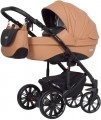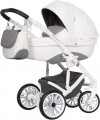Viewing window
A window made of transparent or translucent material, built into the hood that covers the cradle or seating unit. In the version with a walking block,
the viewing window is usually located so that the parent can see the baby directly while moving, without being distracted from controlling the stroller. In cradles, the parent can see the child through a window by approaching the stroller from the side of the hood (that is, on the opposite side of the handle); implementations with a window in the front hemisphere of the hood are less common. In addition, a baby lying in a cradle can usually see the outside world through the window (primarily the sky above the stroller). The viewing window can be made in the form of oilcloth or a mesh mosquito net, through the holes of which air freely penetrates, but insects and small debris raised by the wind are retained.
In box
—
Seat unit. A seat unit serves as the child's sitting area, suitable for use from 6 – 8 months onward when the child transitions from lying in a carrycot to sitting comfortably. All pushchair types feature seat units (see "Design"), except for classic and transformer models. Classic pushchairs inherently use a carrycot, while transformers use a unique device known as a "carrycot-transformer" (see below).
—
Carrycot. A traditional carrycot is a basket with high sides in which the child is lying down. Such baskets are intended for children in the first months of life - usually up to 8 months, no more; from an older age it makes sense to use a seat unit (see above). Carrycots are used in all types of pushchairs, except for pushchairs and transformers (see "Design") - the first type is completed only with seat units, the second uses the so-called " carrycot-transformers" (see below). A special kind of traditional carrycots are carrying carrycots (they are also described below).
—
Carrying carrycot. A variation of the carrycot (see above) designed to be easily carried separately from the pushchair. To do this, the design provides an appropriate handle. At the same time, not every carrycot that has a carrying handle (see above) belongs to this category of accessories: "carrying" are called only those carrycots that initially allow long-term carrying in the hands
...and have various design features that facilitate such transportation.
— Carrycot-transformer. In fact, it is a carrycot, which, if necessary, can be turned into a seat unit for a child who can sit up.
— Car seat. A specialized seat designed for the safe transportation of small children in cars is essential for compliance with safety regulations in many countries. Car seats are typically provided with pushchairs for babies up to 12 months and weighing up to 13 kg. However, a separate seat for older babies must be purchased. Before buying, it's important to check the specifications of the car seat, particularly the method of attaching it to the car.
— Foot cover. A cover designed to protect a child's legs in a pushchair from wind, cold and bad weather. While blankets or improvised solutions can be used for the same goal, complete covers offer more convenience as they securely attach to the pushchair and stay in place during movement. Additionally, if needed, a blanket can be placed inside the cover for extra warmth. It's worth noting that many pushchairs, lacking this accessory, allow for separate purchase. This accessory is primarily used with seat units, whereas carrycots rely on a leg-area canopy with a similar function, though it's not classified as a cover.
— Rain cover. A waterproof cover that protects the child in the pushchair from rain, snow and strong winds. Usually such a cover is made of transparent material or has transparent inserts — so that the baby can see the world around, and the parent can follow the baby. Rain covers for pushchairs are also sold separately, but if such an accessory is included in the kit, you do not have to worry about compatibility.
— Mosquito net. Mesh with small cells, which can cover a child sitting in a pushchair. The cells allow air to pass through, but trap mosquitoes, midges and other harmful insects, as well as small debris raised by the wind; such protection is especially useful during evening walks in the warm season, as well as when going out in the countryside.
— Bag / backpack for things. A separate bag that is usually hung on the handle of the pushchair. In such a bag you can keep various useful small things that need quick access: food, toys and hygiene items for the baby, parent's documents, etc. In most cases, the bag is removable, which provides additional convenience. Note that for some models, initially not equipped with a bag, such an accessory can be purchased separately. And some models are equipped with a backpack — a more convenient option for use.
— Shopping compartment. A device in the form of a basket or container installed at the bottom of the pushchair - under the cradle or seat unit. This compartment is convenient for storing purchases and other things that do not require quick access while walking. At the same time, larger and heavier items are placed in the basket/container than in a bag for things (see above); and the low position improves the stability of the pushchair. The shopping compartment can be either open or closed. The first option is found everywhere, the second - mainly in elite models (and such pushchairs can be supplied with two baskets: open and closed, or in different colors). The capacity of a closed compartment is often smaller, but the contents in it are securely hidden from prying prying eyes and protected from dust, dirt and moisture. Compartments for purchases are made from a wide variety of materials: plastic, metal mesh, fabric, etc. Soft materials are generally lighter, but less durable, hard ones are reliable, but can interfere when overcoming curbs and other obstacles.
— Cup holder. A stand on the parental handle to hold a glass or bottle with a drink - for example, milk for the baby or water for the parent.
— Hand strap. Strap on the handle of the pushchair, which the parent can put on his hand. This reduces the risk of dropping the pushchair: the strap is likely to keep it close to the parent, even if the arms are fully unclenched.
— Hand muff. An accessory that can come in handy when strolling in the cold season. The muff is attached to the handle of the pushchair; if desired, you can hide your hands in it so that they do not freeze in the cold. At the same time, the design of the muff is such that it does not interfere with fully holding the handle and driving the pushchair.
— Cover for pushchair. A protective cover designed for storing and transporting a pushchair during non-use hours is typically made from soft materials. It primarily protects the structure from dirt, direct sunlight, and moisture to some extent. While it offers symbolic protection against mechanical damage, more substantial safeguarding would require a case made of rigid materials. However, the need for such intensive protection is rare in practice. Soft covers are favored for their lightweight nature and minimal storage space when folded, making them the most popular choice for pushchairs. Overall, a complete cover tends to be more convenient, practical, and reliable compared to makeshift packaging.Country of origin
The country of origin of the brand under which the product is marketed. Often indicated by the nationality of the company or the location of its headquarters. At the same time, the actual production capacity of the brand often differs from the country of origin.
It should be noted that the quality of products depends not much on geography as on the organization of processes and quality control at all stages of production. Therefore, national prejudices about brands from certain regions are usually not supported by anything. It is only necessary to pay attention to the country of origin of a brand if the goal is to support or avoid a manufacturer from a particular country.

